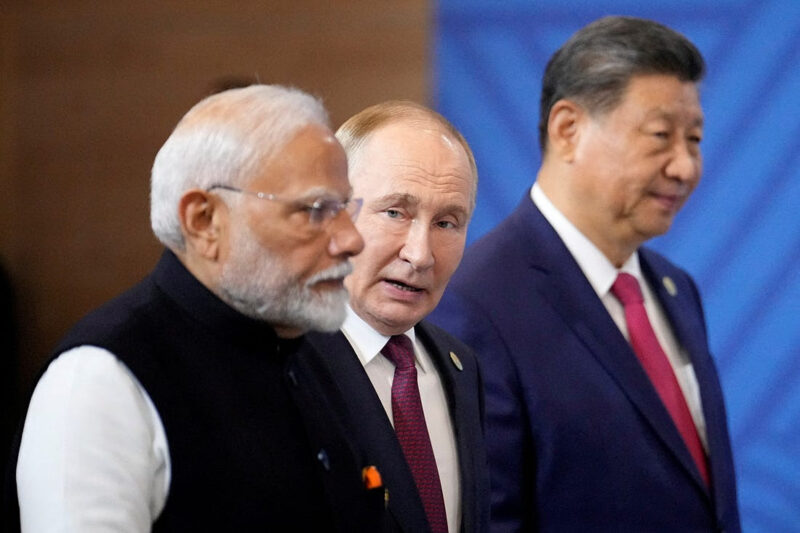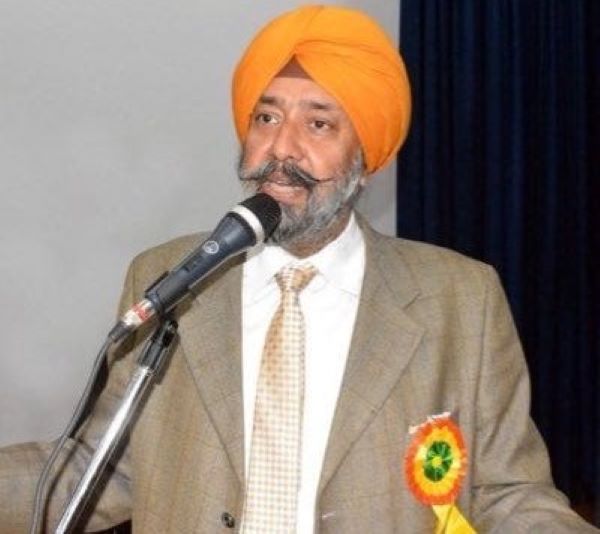 Indian PM Narendra Modi, Russian President Vladimir Putin, and Chinese President Xi Jinping pose at the BRICS Summit plenary session in Kazan, Russia, 23 October 2024.
Indian PM Narendra Modi, Russian President Vladimir Putin, and Chinese President Xi Jinping pose at the BRICS Summit plenary session in Kazan, Russia, 23 October 2024.
PM Modi in Tianjin
Prime Minister Narendra Modi has landed in Tianjin for the Shanghai Cooperation Organisation (SCO) summit. The symbolism is immediate: an Indian Prime Minister back on Chinese soil after a long interval, in a room where President Xi Jinping and President Vladimir Putin are also present, with Pakistan’s Prime Minister in attendance. The choreography alone ensures that what happens inside—and in the corridors outside—the plenary hall will reverberate well beyond Tianjin, not excluding the White House.
The seven-year return: recalibration after Galwan
This is PM Modi’s first visit to China since the 2018 SCO summit, a seven-year gap bookended by the Galwan clashes of 2020 and the hardening of Indian public opinion that followed. New Delhi’s near-term response then—banning several Chinese apps including TikTok, tightening investment scrutiny, and slowing sensitive technology linkages—did not stop trade flows; if anything, merchandise trade with China expanded even as the deficit deepened. The return to China is, therefore, not capitulation but recalibration: keeping firm guard-rails on the Line of Actual Control (LAC) and technology security while testing whether selective cooperation on supply chains, health security, climate-industry inputs, and market access can be advanced without diluting red lines.
What the SCO is—and what it isn’t
The Shanghai Cooperation Organisation (SCO) began as a regional security and confidence-building platform and has gradually widened into a Eurasian forum that straddles counter-terrorism, economic coordination, connectivity, and energy. India and Pakistan joined in 2017; Iran and Belarus have since enlarged the table. Is the SCO “China-centric”? Beijing’s weight is undeniable—the secretariat is in Beijing and China’s chairmanship sets the tempo when it hosts—but the centre of gravity is genuinely co-shared with Russia and increasingly moderated by India and the Central Asian states. The SCO’s bureaucratic DNA is also different from BRICS. BRICS is global in scope and geared to economic governance; the SCO is regional in sweep and oriented to security and connectivity. There is overlap in membership—but not in mandate.

Karan Bir Singh Sidhu, IAS (Retd.), former Special Chief Secretary, Punjab, writes on the intersection of constitutional probity, due process, and democratic supremacy.
The Triumvirate in Tianjin: Xi–Modi–Putin
Beyond the cameras, the sideline interactions will matter most. A Xi–Modi pull-aside—however brief—will be parsed for signals on border mechanisms, trade irritants, and guard-rails for competitive coexistence. A meeting with Putin will be read through the lens of energy flows, payments, and the space for diplomacy on Ukraine. Pakistan’s presence, via Prime Minister Shehbaz Sharif, is a reminder that subcontinental risk management and SCO security cooperation are inseparable. For New Delhi, the aim is straightforward: talk without conceding, stabilise the frontier where possible, and keep doors open in the neighbourhood without legitimising faits accomplis.
Tariffs, energy and the new trade weather
All of this unfolds under a heavy trade sky. Washington’s recent penal tariff moves on a broad swathe of Indian goods have frozen momentum in the bilateral trade track. The message from the Indian side has been equally consistent: tariffs that disregard supply-chain realities will only re-route trade without reshoring production; cooperation on standards, data, and trusted value chains is a better answer. On energy, U.S. objections to India’s purchases of discounted Russian crude are not new—but New Delhi’s line is unchanged: energy security is a sovereign imperative. Indian refiners, sensitive to discounts, insurance, and payments risk, will optimise their slates; there has been adjustment at the margins, not abandonment. The subtext in Tianjin is that India will bargain hard with Washington for tariff relief and investment depth without surrendering autonomy over its energy basket.
The 90-day U.S.–China lull and the Alaska shock
Two developments set the global backdrop. First, a declared 90-day pause in new U.S.–China tariff escalations has cooled temperatures just enough to allow working-level negotiation to resume. That matters for India because it shapes prices for intermediate goods and the broader tariff mood music. Second, the 15 August meeting between President Trump and President Putin in Alaska—framed as an exploratory opening for a Ukraine ceasefire—ended without a deal, though the process continues. Barely days later, European leaders, including President Zelensky, converged on the White House to signal unity and calibrate next steps. The net effect is sobering: diplomacy is alive, peace is not yet in sight, and global markets will continue to trade on geopolitics as much as on fundamentals.
Panchsheel—with seatbelts
India will reach for familiar vocabulary as it navigates this terrain. The Five Principles of Peaceful Co-existence (Panchsheel)—sovereignty, non-aggression, non-interference, equality and mutual benefit, and peaceful co-existence—remain a helpful diplomatic register, especially when speaking with China. But post-1962 and post-2020, Panchsheel is a floor, not a ceiling. The Indian approach today is Panchsheel with seatbelts: speak the language of sovereign equality while building practical guard-rails at the border, in technology ecosystems, and across critical infrastructure to ensure that goodwill is backed by resilience.
Rare minerals, batteries and the supply-chain hinge
If there is a pragmatic lane to explore in Tianjin, it lies in critical minerals and the upstream inputs for batteries and electronics. India seeks to derisk exposure to single-point suppliers and to create room for domestic manufacturing in grid storage, electric mobility, and electronics assembly. That will require multiple plays: targeted offtake agreements, stakes in overseas mines, technology partnerships for processing, and a standards regime that is open but not naïve. China will see advantage in offering select access in exchange for predictability and market presence; India must ensure that any such access diversifies rather than deepens dependence.
The neighbourhood chessboard: BRI and the littorals
China’s Belt and Road Initiative and its maritime footprint—the so-called “string of pearls”—continue to shape the neighbourhood. Ports and dual-use infrastructure from Sri Lanka to Pakistan and Myanmar are economic assets and strategic enablers. The correct Indian answer is not blanket boycott but presence and partnerships: coastal security, selective co-financing with credible partners, transparent project standards, and last-mile delivery that outperforms opaque alternatives. After a rocky phase, India’s ties with some neighbours—including the Maldives—have seen course-corrections; the broader competition, though, will be decided project-by-project and port-by-port, not by communiqués.
SCO optics and the Global South script
Many influential Western publications will inevitably dwell on the Tianjin tableau: three heavyweight leaders—Xi, Modi and Putin—together at one venue, with the unspoken subtext of devising ways to cope with Trump’s tariffs and tantrums. The optics flatter the idea of a Global South that bargains rather than beseeches. But India should resist any framing that suggests bloc formation. Our tradition has been one of agency without alignment: engage everywhere, entangle nowhere. That means using the SCO to stabilise the continental theatre, BRICS to push long-overdue reform in global economic governance, and the Quad and Europe to advance secure technology and supply-chain resilience—multiples, not binaries.
Europe’s energy caveat and India’s oil calculus
New Delhi’s energy reasoning will also be buttressed by a reality that rarely fits neatly into editorial line-ups: major European economies have continued to source Russian energy in various forms, especially LNG, even as they sanction Moscow elsewhere. The point is not to play “whataboutery”, but to underline a principle: if Europe can keep its lights on while balancing values and interests, India can too. Our crude basket will slowly diversify as prices, shipping, and insurance dynamics evolve; but a hard self-denial—especially in a world of elevated freight and fragmented finance—would be self-harm, not virtue.
The tariff tangle: how India should play the next over
What then is a sensible playbook? First, separate the tracks. Keep the tariff negotiation with Washington intensely bilateral and results-oriented—zero in on carve-outs, transitional relief, standards cooperation, and co-investment that creates American jobs and Indian capacity. Second, keep the LAC insulated from trade bargaining; deterrence and dialogue on the frontier must not become currency for market access. Third, use Tianjin to test micro-deliverables with Beijing—expedited clearances, non-tariff barrier reduction, and regulatory predictability—while widening Indian participation in non-Chinese supply routes for critical inputs. Fourth, lock energy flexibility through diversified term contracts, logistics insurance solutions, and payments plumbing that is transparent, lawful, and resilient.
What to watch in the readouts
When the communiqués and leader readouts drop, read past the adjectives. Look for any language on border stability and disengagement protocols; references to critical minerals, rare earths, or downstream battery value chains; and signals on counter-terrorism and information security that tie subcontinental stability to wider SCO priorities. Watch also for the choreography of meetings—who meets whom, for how long, and with what subsequent spin. Sometimes the most important sentence is the one that quietly survives the draft-to-final process.
India’s dynamic Foreign Policy—by design
For an educated Indian audience and for policy circles at home and in the diaspora, the core message should be clear. This is a dynamic, not reactive, Indian foreign policy. It is not about being a passive observer of the moves, moods, and moments emanating from the White House, Beijing, or the Kremlin. It is about active recalibration: pressing our tariff case with Washington while ring-fencing energy sovereignty; engaging Beijing where interests overlap while hardening resilience where they don’t; and keeping channels to Moscow open without importing conflict. This is what strategic autonomy looks like in practice—pragmatism under pressure, with confidence, not diffidence.
The politics at home: leadership and unity
India’s strength abroad rests on the calibre of its leadership at home. Prime Minister Modi’s dynamic and decisive leadership, backed by the intellectual rigour of External Affairs Minister S. Jaishankar and a professional Indian Foreign Service, has given the country the confidence to engage the world on its own terms. The political leadership sets the vision; the diplomatic corps turns it into strategy.
Equally important is the sense of national unity. In the aftermath of Operation Sindoor, multiple parliamentary delegations—including senior opposition leaders—travelled across the world to explain India’s position. That episode showed how, despite deep ideological divides, India’s democracy can still project a coherent voice abroad when national interests are at stake.
Finally, India’s external strength draws from internal composure. Government must keep citizens informed and Opposition must scrutinise, but performative cynicism weakens the national hand. In these uncertain waters—amid the waves stirred by Trump’s tariffs and tantrums—India must look, and be, united. Debate must not be muted; it must be elevated.
The Prime Minister’s Tianjin sojourn should therefore be seen as more than mere optics. It is a picture of a confident and truly self-reliant India, charting its course in an increasingly uncertain and multipolar world.